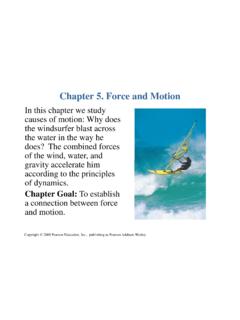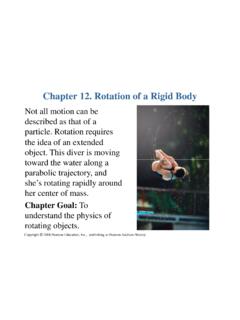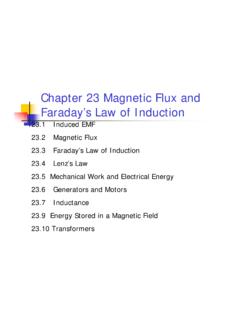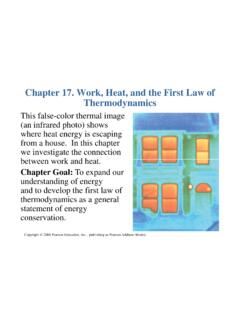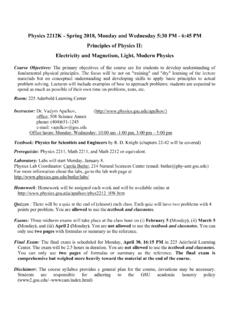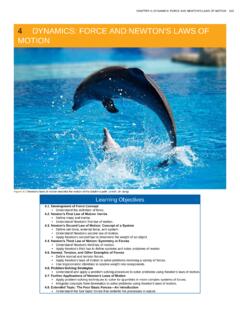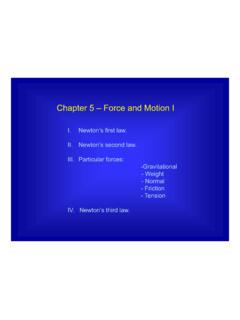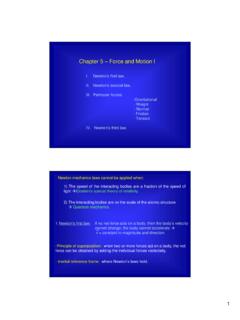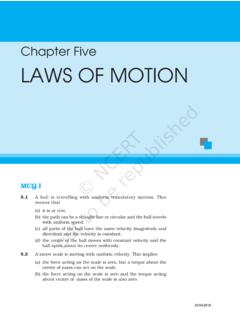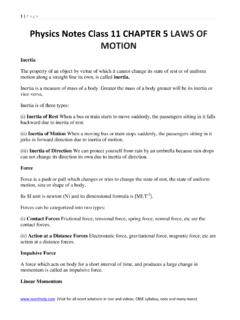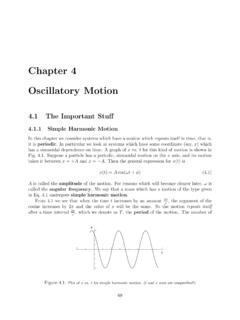Transcription of Chapter 14. Oscillations - Physics & Astronomy
1 Chapter 14. OscillationsThis striking computer-generated image demonstrates an important type of motion: oscillatory motion. Examples of oscillatory motion include a car bouncing up and down, a Copyright 2008 Pearson Education, Inc., publishing as Pearson bouncing up and down, a ringing bell, and the current in an antennaChapter Goal:To understand systems that oscillate with simple harmonic : Simple Harmonic Motion Simple Harmonic Motion and Circular Motion Chapter 14. Oscillations Copyright 2008 Pearson Education, Inc., publishing as Pearson Addison-Wesley. Energy in Simple Harmonic Motion The Dynamics of Simple Harmonic Motion Vertical Oscillations The Pendulum Damped Oscillations Driven Oscillations and Resonance Chapter 14.
2 Reading QuizzesCopyright 2008 Pearson Education, Inc., publishing as Pearson 14. Reading QuizzesWhat is the name of the quantity represented by the symbol A. Angular momentumB. Angular constantCopyright 2008 Pearson Education, Inc., publishing as Pearson constantD. Uniform circular motionE. Centripetal accelerationWhat term is used to describe an oscillator that runs down and eventually stops?A. Tired oscillatorB. Out of shape oscillatorCopyright 2008 Pearson Education, Inc., publishing as Pearson oscillatorD. Resonant oscillatorE. Driven oscillatorThe starting conditions of an oscillator are characterized byA. the initial the phase the phase 2008 Pearson Education, Inc.
3 , publishing as Pearson 14. Basic Content and ExamplesCopyright 2008 Pearson Education, Inc., publishing as Pearson 14. Basic Content and ExamplesSimple Harmonic MotionA system can oscillate in many ways, but we will be especially interested in the smooth sinusoidal oscillation called Simple Harmonic Motion (SHM). The characteristic equation for SHM is a cosine 2008 Pearson Education, Inc., publishing as Pearson argument of the cosine function is in radians. The time to complete one full cycle, or one oscillation, is called the period,T. The frequency, f, is the number of cycles per second. Frequency and period are related bySimple Harmonic MotionCopyright 2008 Pearson Education, Inc.
4 , publishing as Pearson Harmonic MotionThe oscillation frequency fis measured in cycles per second, or may also define an angular frequency in radians per second, to describe the 2008 Pearson Education, Inc., publishing as Pearson position of an object oscillating with SHM can then be written asThe maximum speed of this object isEXAMPLE A system in simple harmonic motionQUESTION:Copyright 2008 Pearson Education, Inc., publishing as Pearson A system in simple harmonic motionCopyright 2008 Pearson Education, Inc., publishing as Pearson A system in simple harmonic motionCopyright 2008 Pearson Education, Inc., publishing as Pearson A system in simple harmonic motionCopyright 2008 Pearson Education, Inc.
5 , publishing as Pearson A system in simple harmonic motionCopyright 2008 Pearson Education, Inc., publishing as Pearson 2008 Pearson Education, Inc., publishing as Pearson Harmonic MotionIf the initial position of an object in SHM is not A, then we may still use the cosine function, with a phase constant measured in this case, the two primary kinematic equations of SHM are: Copyright 2008 Pearson Education, Inc., publishing as Pearson : EXAMPLE Using the initial conditionsQUESTION:Copyright 2008 Pearson Education, Inc., publishing as Pearson Using the initial conditionsCopyright 2008 Pearson Education, Inc., publishing as Pearson Using the initial conditionsCopyright 2008 Pearson Education, Inc.
6 , publishing as Pearson Using the initial conditionsCopyright 2008 Pearson Education, Inc., publishing as Pearson Using the initial conditionsCopyright 2008 Pearson Education, Inc., publishing as Pearson 2008 Pearson Education, Inc., publishing as Pearson in Simple Harmonic MotionEnergy is conserved in 2008 Pearson Education, Inc., publishing as Pearson Using conservation of energyQUESTION:Copyright 2008 Pearson Education, Inc., publishing as Pearson Using conservation of energyCopyright 2008 Pearson Education, Inc., publishing as Pearson Using conservation of energyCopyright 2008 Pearson Education, Inc., publishing as Pearson of Simple Harmonic MotionThe acceleration of an object in SHM is maximum when the displacement is most negative, minimum when the displacement is at a maximum, and zero when x= 0.
7 The derivative of the velocity 2008 Pearson Education, Inc., publishing as Pearson x= Acos t, this can be written asCopyright 2008 Pearson Education, Inc., publishing as Pearson of Simple Harmonic MotionWhen we combine Hooke s Lawfor a mass on a spring with Newton s second law, we obtain the equation of motionfor a mass on a 2008 Pearson Education, Inc., publishing as Pearson solution of this equation of motion iswhere the angular frequencyis determined by the mass and the spring OscillationsMotion for a mass hanging from a spring is the same as for horizontal SHM, but the equilibrium position is 2008 Pearson Education, Inc., publishing as Pearson Bungee oscillationsQUESTION:Copyright 2008 Pearson Education, Inc.
8 , publishing as Pearson Bungee oscillationsCopyright 2008 Pearson Education, Inc., publishing as Pearson Bungee oscillationsCopyright 2008 Pearson Education, Inc., publishing as Pearson Bungee oscillationsCopyright 2008 Pearson Education, Inc., publishing as Pearson Bungee oscillationsCopyright 2008 Pearson Education, Inc., publishing as Pearson Bungee oscillationsCopyright 2008 Pearson Education, Inc., publishing as Pearson PendulumConsider a mass mattached to a string of length L. If it is displaced from its lowest position by an angle , Newton s second law for the Copyright 2008 Pearson Education, Inc., publishing as Pearson s second law for the tangential component, parallel to the motion, isThe PendulumSuppose we restrict the pendulum s Oscillations to small angles (< 10 ).
9 Then we may use the small angle approximationsin , where is measured in radians. Since = s/L, the net force on the mass isCopyright 2008 Pearson Education, Inc., publishing as Pearson the angular frequency of the motion is found to beEXAMPLE The maximum angle of a pendulumQUESTION:Copyright 2008 Pearson Education, Inc., publishing as Pearson The maximum angle of a pendulumCopyright 2008 Pearson Education, Inc., publishing as Pearson The maximum angle of a pendulumCopyright 2008 Pearson Education, Inc., publishing as Pearson The maximum angle of a pendulumCopyright 2008 Pearson Education, Inc., publishing as Pearson : Identifying and analyzing simple harmonic motionCopyright 2008 Pearson Education, Inc.
10 , publishing as Pearson : Identifying and analyzing simple harmonic motionCopyright 2008 Pearson Education, Inc., publishing as Pearson Oscillations An oscillation that runs down and stops is called a damped oscillation. One possible reason for dissipation of energy is the drag force due to air resistance. This is difficult to calculate exactly but a good model for Copyright 2008 Pearson Education, Inc., publishing as Pearson Addison-Wesley. This is difficult to calculate exactly but a good model for a slowly moving object isDamped OscillationsWhen a mass on a spring experiences the force of the spring as given by Hooke s Law, as well as a drag force of magnitude |D|=bv, the solution isCopyright 2008 Pearson Education, Inc.
